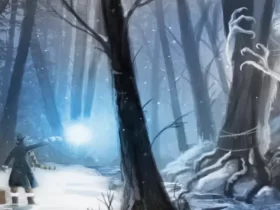Aguara In Mythology
The term “aguara” originates from the Guaraní language and translates to “fox.” In the folklore of the Guaraní people, the aguara-tunpa (literally meaning “Fox-God”) is portrayed as a mischievous entity that wields its power to inflict harm on humans, although it may also display acts of kindness. This trickster figure is similar to the French reynardine and the Japanese kitsune.
Aguara In Witcher Lore Fiction

Illusions can be challenging to distinguish from reality, making it difficult to determine what is real and what is an illusion. While illusions are often used for harmless purposes, such as hiding objects or entrances, they can be dangerous if used to deceive and harm individuals. In Witcher lore, The Aguaras, a creature found on two continents, has mastered the art of magical illusions, telekinesis, and can even manipulate creatures with lower intelligence than humans for a limited time. They are considered one of the most hazardous beings on the continents, and even Witchers have difficulty dealing with them.
Humans are fortunate to not frequently encounter Aguero creatures. If a human gets too close or poses a threat to their territory, the Aguero can use their illusions to make it appear as though there is a dangerous animal, scaring the human away. However, this doesn’t mean Aguera doesn’t interact with elves. The relationship between the elves and Aguara is unique and requires a different explanation.
Related Reads: 13 Facts About Kumiho: 9 Tailed Fox From Korean Mythology
Powers & Abilities

Aguaras possess a formidable ability to wield magic, allowing them to create potent illusions like concealing a riverbed, and to cast spells to control other beings. Despite their non-human form, they have learned to speak the language known as Common, enabling them to communicate with humans.
Reproduction Of The Aguara Fox Demons

Aguara cannot naturally reproduce as their species consists only of females. To reproduce, they must abduct Elven children. Instead, they use magic to turn young Elven girls into new Aguaras. The transformed girls form a close bond with their “mother” Aguara, who will fiercely protect them from anyone trying to take them away. The Aguara will do anything to retrieve her “daughter,” even if it means killing those who stand in her way.
However, when a young elf is taken by an Aguara, the Elven parents do not react with tears or attempt to retrieve their child. They understand the power of the Aguara and know that they will never see their child again. It marks the end of one thing and the beginning of another.
The child will gradually transform into an Aguara, gaining the ability to take on humanoid form. Aguara typically assume one of three forms: the elven woman, the fox creature and the half elf half fox with a humanoid elven body.
Must Read: 19 Werebears Facts That Make Them Cooler Than Other Werewolves
The Aguara can switch between these shapes depending on which one suits their environment or situation best. For example, they might use the humanoid form to blend in or appear attractive to those who have wronged them.
Kitsune Fox & Witcher’s Aguara Similarity

Japanese folklore. Like Aguara, Kitsune are often depicted as possessing magical abilities, including the ability to shape-shift into human form. They are often portrayed as mischievous or deceptive, but can also be benevolent.
In some depictions, kitsune gain more tails as they grow older and become more powerful, and are often associated with the god Inari. Kitsune are a common subject of Japanese folktales, and their depiction has evolved over time to include elements of both good and evil.
In modern culture, kitsune have become popular in anime and manga, as well as in Western pop culture through references in comics, video games, and other media. Some individuals in the otherkin community also identify as kitsune, seeing the shape-shifting fox spirit as a symbol for their own non-human identity.




